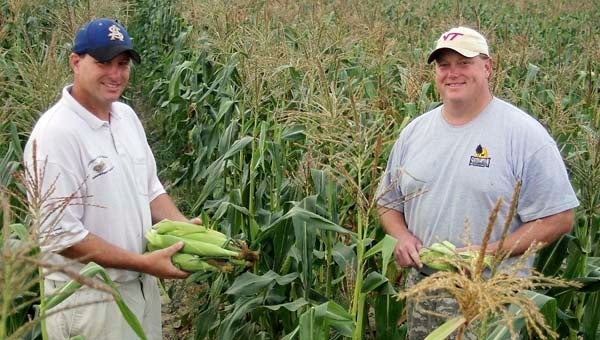Cedar View hoping for successful corn harvests
Published 10:26 am Wednesday, July 10, 2013

Jeffrey Pope, left, and his brother, Mark, of Cedar View Farms in Dreweryville. — CAIN MADDEN/THE TIDEWATER NEWS
DREWRYVILLE—Sweet corn has been thriving at Cedar View Farms in Drewryville, and the rain of recent weeks has evidently been a help.
“The corn crop looks great,” said Jeffrey Pope. “We hope to maintain a good crop throughout the rest of the summer.”
Harvesting started Monday, he said, and with staggered planting that should continue every week until Labor Day.
“We’ve been commercially growing it for 12 years,” said Pope, 42. Initially that began on the farm with the introduction of the farmer’s market in Courtland, he added.
Today, he and his brothers, Chris and Mark, devote 40 acres on average to sweet corn.
The Popes also raise peanuts, grain corn and cotton.
“I think we’re pretty much it,” he said about any other commercial growers of sweet corn in the area.
Chris Drake, extension agent for Southampton County, said there are several smaller growers who produce anywhere from 0.5 to 3.0 acres of sweet corn for sale/wholesale.
He and his brothers, who also have families on the farm, are fourth-generation farmers; their father is the late Sam Pope. The brothers are also the third generation in the family to graduate from Virginia Tech. Jeffrey added that he’s been farming since 1993.
Asked about silver queen, Pope explained it is a variety of sweet corn that came about 40 years ago. Technological advances, such as plant breeding, have created much better varieties since then, he added.
Drake said there are varieties of sweet corn that are “far, far better, even superior to silver queen.”
He added that these other kinds “make for a better yield, better eating quality and have more sugar content.”
Once people try the other varieties, Drake said, they’ll realize how good they taste.
Several people have approached Drake for bi-color corn varieties grown at his family’s farm.
“With corn, whether field or sweet, an abundance or even too much rain is not usually par for the course,” Drake said.
Ordinarily, earworms on corn are an issue by mid to late July. But, he added, “saturated soil conditions have prevented high corn earworm populations.”





